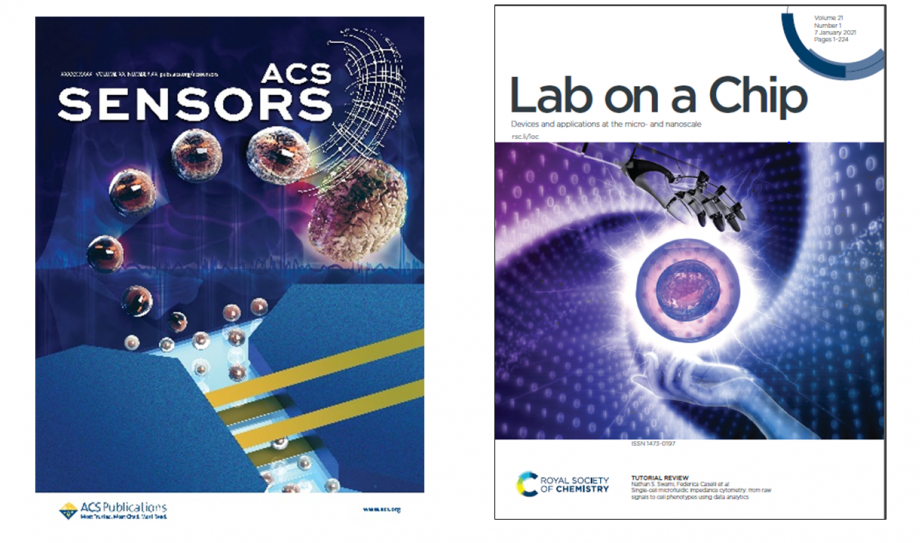Publications

Publications
83. “A novel ultra‐low conductivity electromanipulation buffer improves cell viability and enhances dielectrophoretic consistency”, Alexandra R. Hyler, D. Hong, R.V. Davalos, N. S Swami, E. M Schmelz; Electrophoresis (2021), HTTPS://DOI.ORG/10.1002/ELPS.202000324
82. “Self-aligned sequential lateral field non-uniformities over channel depth for high throughput dielectrophoretic cell deflection”, XuHai Huang, Karina Torres-Castro, Walter Varhue+, Armita Salahi, Ahmed Rasin+, Carlos Honrado+, Audrey Brown, Jennifer Guler, and Nathan S. Swami*, Lab Chip 2021, 21, 835-843, HTTPS://DOI.ORG/10.1039/D0LC01211D
Dielectrophoresis (DEP) enables the separation of cells based on subtle subcellular phenotypic differences by controlling frequency of the applied field. However, current electrode-based geometries extend over a limited depth of the sample channel, thereby reducing the throughput of the manipulated sample (sub-μL/min flow rates and <105 cells/mL). We present a flow through device with self-aligned sequential field non-uniformities extending laterally across the sample channel width (100 μm) that is created by metal patterned over the entire depth (50 μm) of the sample channel sidewall using a single lithography step. This enables single-cell streamlines to undergo progressive DEP deflection with minimal dependence on the cell starting position, its orientation versus the field and intercellular interactions
81. “Label-Free Quantification of Cell Cycle Synchronicity of Human Neural Progenitor Cells Based on Electrophysiology Phenotypes”, C. Honrado+, N. Michel, J. H. Moore, A. Salahi, V. Porterfield, M. J. McConnell, N. S. Swami*; ACS Sensors (2021) 6, 1, 156–165. HTTPS://DOI.ORG/10.1021/ACSSENSORS.0C02022.
The ability to coax human induced pluripotent stem cells (hiPSCs) into human neural progenitor cells (hNPCs) can lead to novel drug discovery and transplant therapy platforms for neurological diseases. Since hNPCs can form organoids that mimic brain development, there is emerging interest in their label-free characterization for controlling cell composition to optimize organoid formation in 3D cultures. However, this requires the ability to quantify hNPCs in heterogeneous samples with subpopulations of similar phenotype. Using high-throughput (>6,000 cells per condition), single-cell impedance cytometry, we present the utilization of electrophysiology for quantification of hNPC subpopulations that are altered in cell cycle synchronicity by camptothecin (CPT) exposure. This label-free detection strategy can prevent loss of cell viability to greatly speed the optimization of cellular compositions for organoid development
80. “Single-cell microfluidic impedance cytometry: from raw signals to cell phenotypes using data analytics”, C. Honrado, P. Bisegna, N. Swami, F. Caselli. Lab on a Chip (2021). 21, 22-54. HTTPS://DOI.ORG/10.1039/D0LC00840K.
“Minimum bactericidal concentration of ciprofloxacin to Pseudomonas aeruginosa determined rapidly based on pyocyanin secretion”, Y. Liu+, J. H. Moore, G. L. Kolling, J. S. McGrath+, J. A. Papin, N. S. Swami*; Sensors and Actuators B: Chemical (2020), 312, 127936.
“Progression-mediated changes in mitochondrial morphology promotes adaptation to hypoxic peritoneal conditions in serous ovarian cancer”, J. P. Grieco, M. E. Allen, J. B. Perry, Y. Wang, Y. Song, A. Rohani, S. L. E. Compton, J. W Smyth, N. S. Swami, D. A. Brown, E. M. Schmelz, Frontiers in Oncology (2020) 10, 3027.
“Quantifying bacterial spore germination by single-cell impedance cytometry for assessment of host microbiota susceptibility to Clostridioides difficile infection”, J. H. Moore, A. Salahi, C. Honrado+, C. Waburton†, C. A. Warren, Swami, N.S.*, Biosensors and Bioelectronics (2020), 166, 112440.
“Self-aligned microfluidic contactless dielectrophoresis device fabricated by single-layer imprinting on cyclic olefin copolymer”, A Salahi, W.B. Varhue+, V. Farmehini, A.R. Hyler, E.M. Schmelz, R.V. Davalos, N.S. Swami*; Analytical and bioanalytical chemistry (2020) 412 (16), 3881-3889.
“Rapid In Vitro Assessment of Clostridioides difficile Inhibition by Probiotics Using Dielectrophoresis to Quantify Cell Structure Alterations”; J.H. Moore, C. Honrado+, V. Stagnaro†, G. Kolling, C.A. Warren, N.S. Swami*, ACS Infectious Diseases (2020), 6 (5), 1000-1007.
“Sensing of diseased mitochondria proportion by DEP at the organelle level of intact cells”, P.Y. Chi, T.W. Chuang, T.T. Chu, C.T. Kuo, Y.T. Wu, V. Farmehini, D.B. Shieh, F.-G. Tseng, Y.-H. Wei, N.S. Swami, C.-F. Chou, SPIE Microfluidics, BioMEMS, and Medical Microsystems (2020) 11235, 112350N. HTTPS://DOI.ORG/10.1117/12.2540653
“A neural network approach for real-time particle/cell characterization in microfluidic impedance cytometry”, C. Honrado, J. McGrath, R. Reale, P. Bisegna, N. Swami*, F. Caselli*; Anal. Bioanal. Chem. (2020) 412, 3835–3845. DOI:10.1007/s00216-020-02497-9.
“High-throughput dynamical analysis of dielectrophoretic frequency dispersion of single-cells based on deflected flow streamlines”, K. Torres-Castro, C. Honrado, W.B. Varhue, V. Farmehini, N. S. Swami*, Anal. Bioanal. Chem. (2020). DOI: 10.1007/s00216-020-02467-1.
“Protozoa and Virus Disinfection by Silver-and Copper-Embedded Ceramic Tablets for Water Purification”, B. Ehdaie, Y.-H. Su, N. S. Swami, J. A. Smith*, Journal of Environmental Engineering (2020) 146 (4), 04020015.
“Electrophysiology-based Stratification of Pancreatic Tumorigenicity by Label-free Single-Cell Impedance Cytometry”. J.S. McGrath+, C. Honrado+, J.H. Moore, S.J. Adair, W.B. Varhue, A. Salahi+, V. Farmehini+, B.J. Goudreau, S. Nagdas, E.M. Blais, T.W. Bauer, N.S. Swami*, Anal Chim Acta (2020) 1101, 90-98. DOI: 10.1016/j.aca.2019.12.033.
“On-Chip Impedance for Quantifying Parasitic Voltages During AC Electrokinetic Trapping”, Farmehini, V.; Varhue, W.; Salahi, A.; Hyler, A.; Cemazar, J.; Davalos, R.; Swami, N.*, IEEE transactions on bio-medical engineering (2020) 67 (6) 1664-1671. DOI: 10.1109/TBME.2019.2942572. (PMID: 31545705).
“Adaptation of mitochondrial organization to aggregation in serous ovarian cancer”, J. P. Grieco, S. Edwards, M. Allen, Y Wang, J. Perry, Y. Song, N. S. Swami, E. Schmelz, Cancer Research (2019) 79, 805.
“Real-Time Electronic Feedback for Improved Acoustic Trapping of Micron-Scale Particles”, C. P. Clark, V. Farmehini, L. Spiers, M. S. Woolf, N. S. Swami, J. P. Landers. Micromachines (2019), 10 (7), 489.
“Crystallization of High Aspect Ratio HKUST-1 Thin Films in Nanoconfined Channels for Selective Molecule Uptake”, S. Guthrie, L. Huelsenbeck, A. Salahi, W. Varhue, N. Smith, X. Yu, L. U. Yoon, J. J. Choi, N. S. Swami, G. Giri, : Nanoscale Adv. (2019), 1, 2946-2952.
“Conductance-Based Biophysical Distinction and Microfluidic Enrichment of Nanovesicles Derived from Pancreatic Tumor Cells of Varying Invasiveness”, J. H. Moore, W. B. Varhue, Y.-H. Su, S. S. Linton, V. Farmehini, T. E. Fox, G. L. Matters, M. Kester, N. S. Swami*, Analytical Chemistry (2019) 91, 10424-10431.
“Electrofabricated biomaterial-based capacitor on nanoporous gold for enhanced redox amplification”, Y. Liu+, J. McGrath+, J. H. Moore, G. L. Kolling, J. A. Papin, N. S. Swami*, Electrochimica Acta (2019), 318, 828-836.
“Single-cell electro-phenotyping for rapid assessment of Clostridium difficile heterogeneity under vancomycin treatment at sub-MIC (minimum inhibitory concentration) levels”; A. Rohani, J.H. Moore, Y-H. Su, V. Stagnaro†, C.A. Warren, N.S. Swami*, Sensors & Actuators B: Chemical (2018), 276, 472-480.
“Optofluidic and Electrochemical Nanoslits for Rapid Measurement of Receptor Binding to Neuropeptides”, NS Swami, WB Varhue, C Chou, IEEE Research and Applications of Photonics (2018), 250, 450.
“A Novel Approach to Artifact-Free EMG Recording During Electrical Stimulation-Induced Muscle Activation”, V. Farmehini, N. Swami*, P. Faghri, M. Vromans, Archives of Physical Medicine and Rehabilitation (2017) 98 (10), e26.
“Deformability-based microfluidic separation of pancreatic islets from exocrine acinar tissue for transplant applications”; W. Varhue, L. Langman, M. Kelly-Goss, M. Lataillade, K. L. Brayman, S. Peirce-Cottler, N. S. Swami*, Lab Chip (2017) 17, 3682 – 3691.
The long-term management type-1 diabetes (T1D) is currently achieved through lifelong exogenous insulin injections. Although there is no cure for T1D, transplantation of pancreatic islet of Langerhans has the potential to restore normal endocrine function versus the morbidity of hypoglycemic unawareness that is commonly associated with sudden death among fragile diabetics. However, since endocrine islet tissues form a small proportion of the pancreas, sufficient islet numbers can be reached only by combining islets from multiple organ donors and the transplant plug contains significantly high levels of exocrine acinar tissue, thereby exacerbating immune responses that stress islet cells. We show that in comparison to the significant size and density overlaps between the islet and acinar tissue populations post-organ digestion, their deformability overlaps are minimal. This feature is utilized to design a microfluidic separation strategy, wherein tangential flows enable selective deformation of acinar populations towards the bifurcating waste stream and sequential switching of hydrodynamic resistance enables the collection of rigid islets.
“Frequency-selective electrokinetic enrichment of biomolecules in physiological media based on electrical double-layer polarization”; A. Rohani, B. J. Sanghavi, A. Salahi, K. –T. Liao, C.-F. Chou, N.S. Swami*, Nanoscale (2017), DOI: 10.1039/C7NR02376F.
Proteomic biomarkers of interest to the early diagnosis of diseases and infections are present at trace levels versus interfering species. Hence, their selective enrichment is needed within bio-assays for speeding binding kinetics with receptors and for reducing signal interferences. We present the utilization of AC electrokinetics to enable frequency-selective enrichment of nanocolloidal biomolecules, based on the characteristic time constant for polarization of their electrical double-layer, since surface conduction in their ion cloud depends on colloidal size, shape and surface charge. Through coupling enrichment to capture by receptors on graphene-modified surfaces, we demonstrate the elimination of false positives caused by anti-mouse immunoglobulin antibodies to the PSA immunoassay.
“Label-free quantification of intracellular mitochondrial dynamics using dielectrophoresis”; Rohani, A.; Moore, J.; Kashatus, J.; Sesaki, H.; Kashatus, D.; Swami, N. S., Anal Chem (2017) 89 (11), pp 5757–5764. DOI: 10.1021/acs.analchem.6b04666.
Mitochondrial dynamics play an important role within several pathological conditions, including cancer and neurological diseases. For the purpose of identifying therapies that target aberrant regulation of the mitochondrial dynamics machinery and characterizing the regulating signaling pathways, there is a need for label-free means to detect the dynamic alterations in mitochondrial morphology. We present the use of dielectrophoresis for label-free quantification of intracellular mitochondrial modifications that alter cytoplasmic conductivity and these changes are benchmarked against label-based image analysis of the mitochondrial network. This is validated by quantifying the mitochondrial alterations that are carried out by entirely independent means on two different cell lines: human embryonic kidney cells and mouse embryonic fibroblasts. In both cell lines, the inhibition of mitochondrial fission that leads to a mitochondrial structure of higher connectivity is shown to substantially enhance conductivity of the cell interior.
“Microbial analysis in dielectrophoretic microfluidic systems”; R. E. Fernandez, A. Rohani, V. Farmehini, N. S. Swami*. Analytica Chimica Acta (2017) 966, 11-33. HTTPS://DOI.ORG/10.1016/J.ACA.2017.02.024
Infections caused by various known and emerging pathogenic microorganisms, including antibiotic-resistant strains, are a major threat to global health and well-being. This highlights the urgent need for detection systems for microbial identification, quantification and characterization towards assessing infections, prescribing therapies and understanding the dynamic cellular modifications. Current state-of-the-art microbial detection systems exhibit a trade-off between sensitivity and assay time, which could be alleviated by selective and label-free microbial capture onto the sensor surface from dilute samples. AC electrokinetic methods, such as dielectrophoresis, enable frequency-selective capture of viable microbial cells and spores due to polarization based on their distinguishing size, shape and sub-cellular compositional characteristics, for downstream coupling to various detection modalities. Following elucidation of the polarization mechanisms that distinguish bacterial cells from each other, as well as from mammalian cells, this review compares the microfluidic platforms for dielectrophoretic manipulation of microbials and their coupling to various detection modalities, including immuno-capture, impedance measurement, Raman spectroscopy and nucleic acid amplification methods, as well as for phenotypic assessment of microbial viability and antibiotic susceptibility.

Principal Investigator - Nathan Swami